BIRD FEEDING 101: HOW TO CHOOSE THE RIGHT FEEDER FOR YOUR HOME!

So you’ve decided you want to have some chirping company. Hurrah!
You’re not alone. Birding has become one of the most popular hobbies in North America, second only to gardening. 57 million households have taken up bird-feeding as a hobby. In fact, February has been named National Bird-Feeding Month by congressional decree.
And by this decree, ladies and gents, we shall show you how to attract the little chirpers to your backyard. Whether in an apartment or condo or a house with a backyard, we’ll show you step by step how enter to the world of bird feeding.
Where do we start?
Getting to know the birds around you
Before you choose your bird feeder, get to know the birds that are in your backyard or neighbourhood. According to the Cornell Lab of Ornithology, there are 15 common types of bird in North America; Chickadees, Northern Cardinals and Hummingbirds being the most popular with bird lovers. Check them out and get to know your natural neighbors.
Bird Identification.
Do you keep seeing the same bird every day and yet have no idea what it's called? Check out a guide to help you identify it. So satisfying to know who you're sharing your coffee break with!
Four important pieces of advice to consider before buying a feeder.
Whichever decision you make, these four pieces of advice are key before you begin.
1. Safety from predators: The location and type of bird feeder should prevent squirrels, cats and other predators from harming our feathery visitors.
2. Winter proof: Make sure the bird feeder is sturdy enough to survive the cold seasons.
3. Ease of use: Cleanliness is key. Make sure the feeders you choose are easy to hang and easy to clean.
4. Patience! It takes time for these (rightfully) suspicious flyers to trust you. They need time to get to know you, to be sure you’re not there to harm them but are merely trying to pamper them with yummy seeds and delicious nectar.
Once you understand the fab four, you’ll realise why it’s worth having a bird feeder: this is an easy and low budget hobby that brings oodles of joy.

Now to the brass tacks: Which of these feeders are right for you?
• Love chickadees, titmice and cardinals right at your window? Check out: Window feeders.
• Prefer jays and sparrows? Check out: Tray feeders.
• Love hummingbirds and orioles? Check out Nectar feeders
• Maybe orioles and tanagers? Check out Fruit feeders.
• Fan of woodpeckers and nuthatches? Check out Suet feeders.
• Like finches and chickadees? Check out: Tube feeders.
• Into goldfinches and siskins? Check out Thistle/Nyjer feeders.
• Fancy cardinals and grosbeaks? Check out: Hopper feeders.
• Love magpies and nuthatches? Check out Peanut feeders.
WINDOW FEEDERS
Window feeders are small plastic boxes (or platforms) that attach to the window by suction.
The beautiful thing about these type of feeders is that they keep birds safe. Not only from predators but also from flying into your window and harming themselves. The window feeders are not only a source of nutrition - but also a signal for them to slow down and avoid collision.
Of course the greatest benefit of a window feeder is that it attracts your feathered friends up close and personal. It takes a while for them to get used to you and realise that you’re “legit” and a trustworthy food source. But once they do - they practically become family members. And then the fun begins!
Nature at your fingertips!
If you move slowly enough, you can walk right up to your window and observe your pecking visitor in action, see how he moves about, see from close-up the intricate shades of his feathers, the color of his eyes. Nature at its best at your fingertips.
Gossip of the day!

Once the birds become regulars, you can have family updates of which birds are fighting, who had chicks, which mating songs they are singing today. Children and grandchildren can get really excited when a red cardinal appears or when certain birds return from migration.
Pets have pets?
Other family members who can enjoy the fun? Your pet! Cats and dogs love staring at your frequent-flyers for hours! I like imagining what my cat is thinking as he stares at the bird feeder right in front of him, languidly pawing at the window.
This is a great choice for all bird lovers - and especially apartment/condo owners or for those have a serious squirrel problem.
Tips for window feeders
1. Size matters: Window feeders come in all sizes and shapes. The smaller the size, the smaller the birds. If you want to attract larger birds such as bluebirds, cardinals and goldfinches, get a window feeder compatible with their size.
2. Cleanliness: As the birds eat the seeds, so do they make a mess, especially when eating seeds with husks which land up below the bird-feeder and must be removed. It is important to change and clean the feeder almost every day. Luckily, this is one of the easiest window feeders to clean!
3. Suction matters! Apart from the durable plastic of the bird feeder, suction is an important consideration when using a window feeder. Having clean windows is key for successful suction to work. Click here for more tips on how to attach the suction cups to your window properly.
4. Warning: Some companies or bloggers recommend getting a one-way mirrored film for the feeder, claiming that the birds won’t see you approaching and fly away since they can only see their reflection. This actually produces the opposite effect. It can cause territorial males to attack their own reflection and result in serious injury...
5. Attract them to you! To help the birds find this new source of nutrition, try giving them their favourite treats: peanuts, seeds and fat balls. Bright seeds can attract them even more! If you have a garden, try to take any other food source away so the birds will focus on the window feeder.
All in all:
It’s no surprise that window feeders are the leading choice when it comes to choosing bird feeders. It’s easy to set up, easy to clean, and will hold up forever.
Who will “come for dinner?” It all depends on the size, colour and type of food!

TRAY FEEDERS
Another great option to attract as many types of birds as possible is the tray feeder.
This is the simplest type. Any seeds/fruit/peanuts/shell worms/dried fruit/small suet nuggets, whatever you have can be placed on it. Edged at the rim, it prevents the seeds from falling. You can hang it, place it on anything or just on the ground. They are easy to mount and easy to clean!
And because of this - come one come all. In the bird world, we call this a “non-exclusive” feeder - because there are no intricate portals or holes, any bird can feed from this tray, so you basically get the greatest variety of species.
Trays feeders are at the top of the list for cardinals! Offer them sunflower or safflower seeds and they’ll be there!
Tips for Tray Feeders:
1. It's raining it's pouring! Because these feeders have no cover, they are not protected against rain and snow. Wet seeds can develop fungus and become mouldy which can endanger our little flyers - so a good option is to get a feeder which will allow the water to drip through.
2. The importance of cleanliness. Lack of cover also means droppings. Give your feeder a good cleaning! Empty the tray from time to time, scraping out leftovers and washing it well.
3. Beware predators! If you have squirrels or chipmunks in your backyard- this tray is manna from heaven! If this is the case, try hanging the trays up or use a squirrel baffle.
4. No place to hang a feeder? No problem! If you do choose to put the feeder on the ground, make sure the ground is bare or that the lawn is mowed so the birds can see if a cat is lying in wait and planning an attack.
Birds that are attracted to tray feeders… well, nearly (but not all) of the 98 species in north America! This includes:

Nectar feeders

Buzz buzz buzz…. The hummingbirds are abuzz!
The purpose of this delightful option is to attract hummingbirds! Such a unique bird that is just heavenly to watch, it is no surprise many buy this type of feeder!
Because of its popularity, some companies go all out and design super fancy nectar feeders - but as per the rule of the fab-four above, they do not always do the job!
Hummingbird feeders are actually quite simple: a plastic dish with a top or a bottle-type tube. Usually in red because Hummingbirds looove that colour.
What is nectar, and why use it?
Nectar is basically sugar dissolved in water. Birds have a high metabolic rate, and their activities consume many calories - which is why the high rates of sugar in the nectar is essential for them. Of course they need other caloric intake as well, but for them these feeders serve as another way to get the sugar they would sip from a flower's nectar. Nectar feeders are a blessing to them, especially in winter, where hummingbirds' survival could depend on these little sugary ports that give them a dose of energy and possibly save their lives. But use plain white sugar only, no honey or artificial sweeteners..
Tips for nectar feeders:
1. Refresh! Nectar goes bad very fast, especially during the warm weather, so it's good to refresh the sugar water and refuel the feeder frequently.
2. BYOB! A big mistake is to colour the nectar red. Don’t do this as food coloring is harmful to our little hummers. You can easily make your own nectar! Easy and simple, no 4 course meals here.
3. No spilling. When choosing this type of feeder, make sure the openings are raised well above the level of the sugar water, so leaks will be prevented.4. Bees. Bees can be attracted sugar water spills. And because they carry pollen they can contribute to the mess… Consider hummingbird feeders with red ports rather than yellow - as bees are attracted to that color.
5. Plant red flowers! Red is the hummer’s favourite so why not add a splash of it in your backyard? Hummingbirds will check out anything red. If you leave a red hat on your backyard chair, it will be fully explored! Any tubular shaped flower will be heaven for the little flyer and a good way for him to discover your feeder.

Nectar feeders can also attract a myriad of other birds, such as finches, chickadees and sparrows for starters.
They like to just perch and check out the scenery. Which is why it could be a bonus to have another type of feeder nearby to accommodate these little visitors looking for a bite. For instance, the next feeder up: the oriole feeder.
FRUIT FEEDERS
And now for something completely orange: Orioles!
A splash of orange, black and yellow is a welcome addition to our gardens. Orioles love bird feeders and feel most at home near them. Admiring these fiery birds is as satisfying as listening to their songs.
What they love to eat isn’t messy seeds that cause unwanted weeds - rather: their menu includes nectar, fruit and jelly! In addition, they also eat insects, which is another plus: pest control!
There are customised feeders for these little orange ones. They are structured to feed orioles alone and save them competition with the rest of the flyers.
3 musts for oriole feeders:
1. Oriole feeders should have large holes for their large beaks, as well as small dishes nearby for jelly or mealworms (yum…?)
2. There should be spikes for holding orange or apple halves. You can also feed them with suet cakes.
3. Orioles love the color orange! Most feeders have orange bases and ports. No need to feed them “orange” nectar - as the dye can cause them harm.
Smooth grape-jelly is a fine meal for an oriole! They also eat other fruit jams, but grape jelly seems to be their absolute favorite. Make sure it’s not “diet” jelly or contains any sugar substitutes such as Aspartame. Birds need a full sugar intake to get the energy they need.
Which means that grape jelly must be offered in small quantities so that orioles will also look for protein. Crushed grapes can also be an option - as well as suet.
Orioles might try to drink the nectar from hummingbird feeders, even though the ports are too small for their larger beaks! If you know hummingbird feeders, you will see that they have a tough time pecking into their small ports. Oriole feeders are a great solution, and leaving orange halves in the garden can do the trick.
Tips for oriole feeders:
1. Tickle me orange! If you don't have a feeder with an orange top, try placing an orange ribbon around a tree or a post, so as they glide over your garden and see their favourite color, they will realise that something delicious is waiting for them. And if there’s grape jelly? Well, you've just made a friend for life!
2. Whether the weather! It's best for Oriole feeders to be in place before the spring. Orioles need to know where their food sources are coming from before the season starts - and if they don’t see yours they may not fly over your house until the following season! Hey, if you were after a marathon of migration, you’d need water and food as soon as possible too! You can even offer them sugar dissolved in water, (4:1) this could be a great beginning of a wonderful relationship.
3. Sugar - and then some! As much as grape jelly is a lovely treat for summer, orioles need a little more when it comes to the mating season when they look for protein sources, such as insects. You can help them by placing mealworms in their feeders - or have an extra suet feeder in your garden, which will also do the job!
4. Beware of ants and bees! Oranges and sugary water means ants and bees. If your feeder doesn’t come with an insect guard, consider placing vegetable oil around the port rims. This should keep the ants from "marching one by one."
See the orioles feed in action!
SUET FEEDERS
Ahh, welcome to the world of suet.
Wait, what is suet?!
 Suet is made from the fat that surrounds the kidneys of animals (mostly beef and mutton).The animal fat is easily digested and metabolized by many birds and because it is high in fat, it gives them the energy needed for the harsh weather.
Suet is made from the fat that surrounds the kidneys of animals (mostly beef and mutton).The animal fat is easily digested and metabolized by many birds and because it is high in fat, it gives them the energy needed for the harsh weather.
Another reason to serve suet mainly in winter, is due to the fact that raw suet can go bad quickly once above freezing temperatures.
Suet mixtures are usually comprised of suet and other ingredients including peanut butter, peanuts, seed, cracked corn and birdseed. However, peanuts and corn are prone to bacteria growth, which can ultimately be poisonous for the birds. So make sure you buy the suet from reputable dealers and store it in your refrigerator - or if you have the time and patience - make the suet yourselves!
Suet feeders are easy to fill, and easy to clean. Because of its cake form, the seeds stick to the suet so birds peck it all off until it's gone - a clean plate hardly makes a mess. That way there’s less waste and less a chance squirrels or cats will tip it over.
Birds attracted to suet feeders: chickadees, nuthatches, wrens, thrushes, creepers, thrashers, jays, and nearly all woodpeckers, including flickers. Here's one suet feeder enjoying all the love:
TUBE FEEDERS
Let’s take the size down a notch!
 If smaller birds are your speed, or if you’re looking for an additional feeder in your garden, this is an excellent choice.
If smaller birds are your speed, or if you’re looking for an additional feeder in your garden, this is an excellent choice.
Tube feeders are hanging types with screens through which the birds can eat. You can even hang a few tubes together. The bigger the crowd, the greater the party.
The tube has small perches, which keeps the bigger birds out of the picture. That way the little ones feel safer not having to deal with competition.
Tips for tube hanging:
1. Safety first! If the tube is made well, i.e sturdy and weather proof, it’s pretty predator safe. However it does help having metal caps, bases and seed portals to protect the little flyers from squirrels and wild sparrows.
2. Height second! Try to hang the tube at least five feet in the air and in a location where you can see it from your window, to enjoy the new members of the flying family.
3. Upside down is the straight way up! A great way to attract birds to this type of feeder is to get a tube with portals from which the birds can eat upside down. This technique confuses the enemy (predators and other competitive birds) as the finches munch away!
These tubes will keep grosbeaks and jays out of the picture, but will attract the smaller species that are gorgeous to look at:

THISTLE/NYJER FEEDERS
An even smaller version of the tube feeder, finches will love to know, is the niger feeder, pronounced NYE-jerr. Nyjer was trademarked in 1998 by the Wild Bird Feeding Industry. These feeders are especially designed to dispense nyjer, which is the seeds of Guizotia abyssinica, a dainty yellow flower native to Africa.
 (Though Niger implies Nigeria - this seed was originally cultivated in the Ethiopian highlands. Go figure! In addition, nyjer has nothing to do with thistle. They are often confused as finches eat both thistle and nyjer.)
(Though Niger implies Nigeria - this seed was originally cultivated in the Ethiopian highlands. Go figure! In addition, nyjer has nothing to do with thistle. They are often confused as finches eat both thistle and nyjer.)
Nyjer seeds are presented in a tube with tiny holes from which the birds have to pull out the seeds, as they are small and can fall out, as opposed to the tray, on which the seeds lay open to be pecked.
These small black seeds are filled with oil and high in calories - a favourite for birds, especially in the cold weather.
You will need a bird feeder suitable for the size of the seeds , a bottom tray and a tube that can be easily cleaned. It is also good to get a tube that has enough space for birds to land on, especially in spring, when finches flit in and out in flocks. It’s a grand sight to see so many birds in your garden!
Sometimes the tubes come in a spiral shape. This way more birds can stand on the tube at the same time and take turns to peck.
You can get a tube feeder with the holes facing up, as we mentioned in tube feeders. In nature finches eat upside down to adjust themselves to the angle of the flowers, so with these types they will feel quite at home.
Nyjer seeds are a little more expensive since they are imported from afar. They are treated at high temperature to prevent seeds which the birds drop on the ground turn into weeds. However it is common to mix them with other “finch mixes” which gives the colourful perchers a little extra variety on the menu.
Tips for Nyjer seed feeders.
1. Keep’em fresh! The finches might turn up their beaks at dry seeds.
2. Keep'em clean! These seeds can go mouldy. If they do go bad, scrub the feeder thoroughly with a 10% bleach solution and wash out. Good thing is these feeders are easy to clean.
3. Size: Choose feeders with a small mesh or feeding ports small enough to release the nyjer seeds without spilling.
4. Winter is your best bet, as many non-migratory songbirds run out of natural supplies in winter, so thistle seed feeders, just like the suet, will be a welcome addition to their diet.
5. First timers: If this is your first time with a nyjer feeder, start with mixed seeds that includes nyjer, to help the birds get acquainted with them.
Orioles, waxwings and hummingbirds won't be attracted to this feeder. Sometimes woodpeckers, thrushes and chickadees might visit - but check below the usual nyjer clients:

HOPPER FEEDERS
Another big favourite of the wild birds is the hopper. The birds “hop" on the hopper’s trigger which then releases seeds, an extremely comfortable way for them to eat. These feeders are usually a cone shaped/inverted pyramid - with a roof on top, which is why they are also called House Feeders.
Hoppers excel at protecting the seeds from bad weather. The container is closed, so the seeds are kept clean and sanitary. They are also a really good option for fending off predators as well as preventing bird droppings.
The hopper will hold seeds for days! It’s like a big pantry for birds, come one come all. However, you must invest in its CLEANLINESS. If the seeds get wet, they can develop bacteria and fungus, which can spread disease among the birds. Though they are a little tough to clean, this is truly a beauty in the garden.
Tips for hanging a hopper feeder:
1. Height: Hoppers are usually suspended 5 feet off the ground - (eye level) or mounted on a pole. Some birds, like Jays, prefer the stability of the pole rather than the hanging kind. It should ideally be 16 feet away from trees or bushes, so if a hawk is around, the birds will have plenty of time to flee.
2. Beware Squirrels: If squirrels are your regulars, you may need to consider a squirrel baffle.
3. A weight-sensing perch: Any percher weighing more than an average songbird will cause the Hopper feeder to close its portals, leaving only the smaller birds to enjoy the feast undisturbed by their bigger foes.
Bird hoppers attract finches, jays, cardinals, buntings, grosbeaks, sparrows, chickadees, titmice, nuthatches, woodpeckers and blackbirds. A big party. Check out this festive gathering on a gazebo hopper:
PEANUT FEEDERS
Come summer, this is an excellent substitute for suet.
Peanuts are a very good source of nutrition not only for us humans but for birds as well. They are high in fat - which gives them a good amount of calories to get through the day, especially in winter.
Peanuts are a slightly more expensive offering but a favourite among bird feeders as they attract a different variety of birds. For instance, jays can smell peanuts from a 5 mile radius - so if you start putting peanut feeders in your garden, expect the jay to be your new BBF! (best bird forever.)
You can offer whole peanuts, shelled or not. Some birds will eat them as is, and some will crush them with their beaks to bird-bite sizes.
Peanuts feeders are a favorite among bird lovers as it takes longer for the bird to peck and eat the nut. The longer it stays, the longer we get to spend time looking at them and enjoying their company. This could indirectly start to build trust between us bird lovers and our visitors.
Peanut tips:
1. Fresh the mesh! Peanuts can go bad in a few days - so it’s best to give them the right amount they consume per day, before refilling.
2. Storage: Store the peanuts in a dry area so they don’t go mouldy.
3. Natural only: Avoid salty peanuts or any other processed kind. Natural unroasted peanuts only!
Birds peanut feeders attract: Jays, Woodpeckers, Chickadees, Titmice, Nuthatches, Magpies. Sparrows, House finches and Cardinals. Watch these two fight it out:
Now that you've selected your bird feeder. What next?
Now that you’ve chosen a bird feeder, here are a few tips to consider before setting it up, other than the fab-four:
REMEMBER, PATIENCE IS A VIRTUE As we mentioned in the fab-four, it takes time till these little flyers get used to you. It could take days or even months!
THINK BIG, START SMALL: Since the birds will take their time, try to put out a small amount of food at first, since it can get wet or dry out. Waste not want not. As they start to visit more often, the amount of seed can grow proportionately.
LOCATION, LOCATION, LOCATION: Make sure you hang the feeder of your choice where you can clearly can see it and enjoy it from your window!
KEEP IT CLEAN, BOYS AND GIRLS: I can't stress enough how cleanliness is key. Make sure your seeds are fresh and available. Birds need to trust their bird feeder to be full everyday. If they come back to an empty feeder, they will consider this source untrustworthy. Also, if it rains, make sure to change the seeds before they go mouldy which can cause diseases. Avoid bird mould - avoid diseases.
BEWARE WHAT YOU FEED: Buy your seeds from vetted seed sellers, so you're not giving them seeds empty of minerals and calories. Not all kitchen scraps are good for birds: white bread for instance, has no nutrients in it whatsoever.
Also: Processed peanuts should never be offered to birds. That means salted, smoked or seasoned as well as any peanuts coated with candy or chocolate which can be dangerous for birds. Similarly, no baked goods, not even oatmeal cookies! Cakes, brownies or fudge even with peanuts, should not be offered to our flyers. Let's keep our songbirds safe
WHERE DO YOU HANG THE FEEDER?
An average squirrel can leap up to about 4 feet up in the air, between 8 to 10 feet sideways, and even further when jumping down from above. So try placing your bird feeder over 4 feet high and 10 feet away from anything the squirrel can climb. Another way to keep the squirrels away is to add hot pepper to your seeds! Click here for more tips how to keep the squirrels away.
STILL NOT CONVINCED? HOW ABOUT JUST WATER?
Even if you end up not placing any bird feeders in your garden, believe it or not, providing water for wild birds is just as important as providing seed. Just like us, birds need hydration and a good bath every day to wash away dirt and parasites.
Having a water source, whether it's a bird bath or any other water holder, could attract some beautiful birds to keep you company, and give
you a chance to enjoy their vibrant beauty up close.



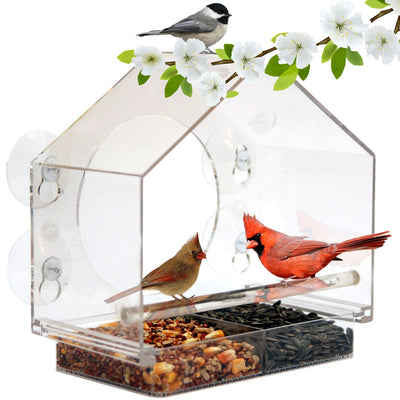
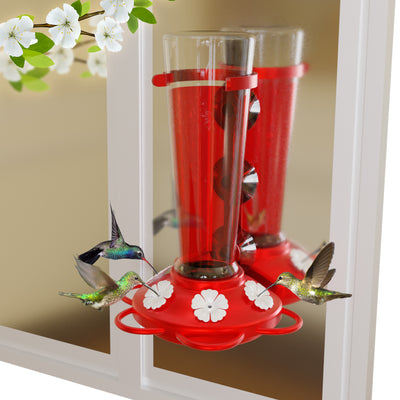
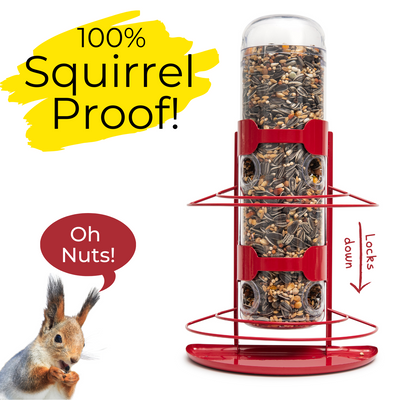
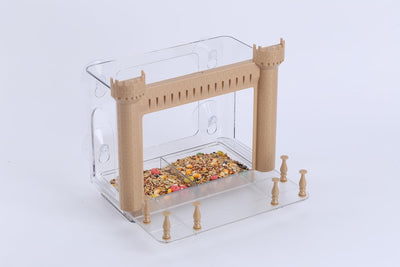
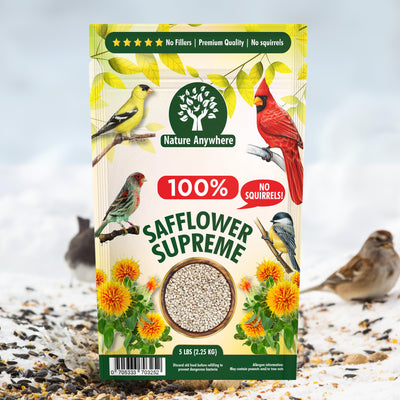

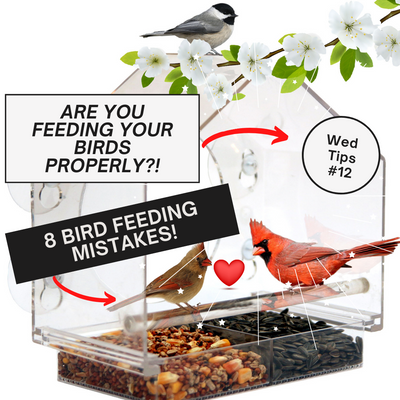
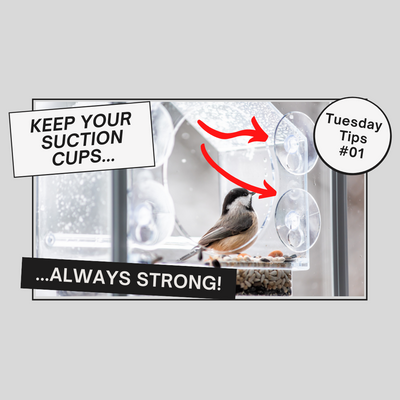
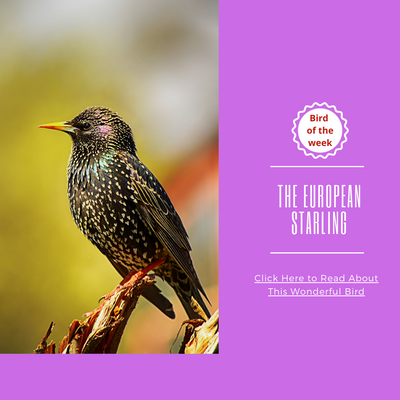
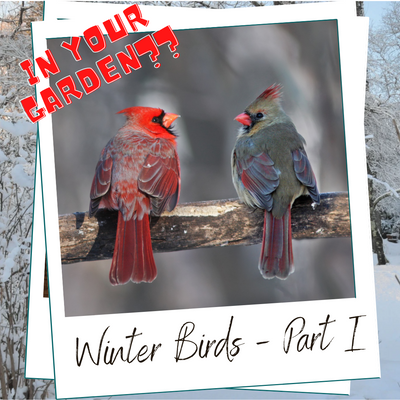
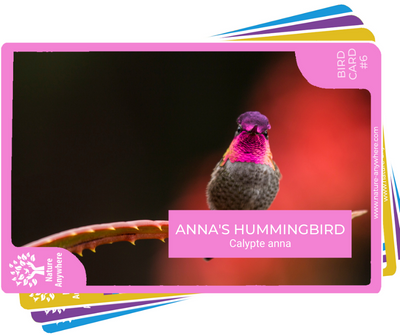
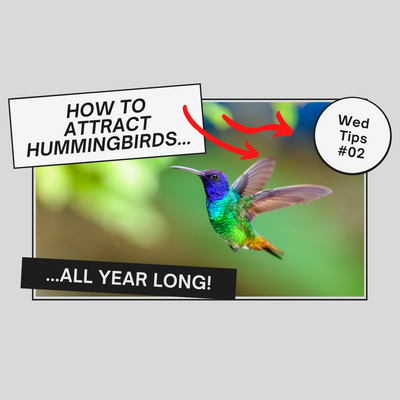
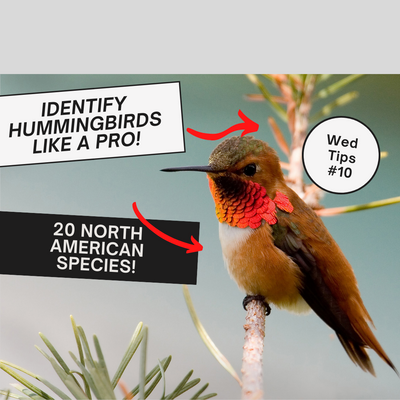
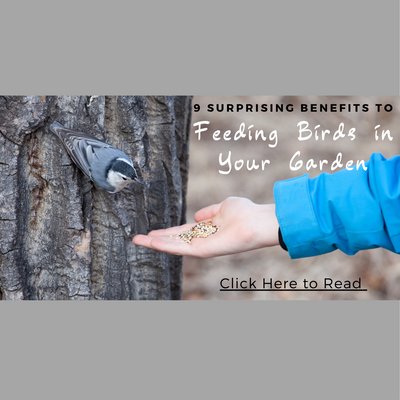
I like your tip about making sure the bird feeder is sturdy enough to survive the cold seasons. My son loves animals and so we want to hang a bird feeder outside his window so they will come to visit him. I am hoping to find one that will attract more interesting birds so that my son can study them. http://www.copperfieldgifts.com/outdoor/patio-lawn-garden/bird-feeders.html
We are loving our window bird feeder! Seeing the cardinals and finches up close while in the kitchen is so relaxing and can instantly put you in a good mood:). Love this website chock-full of information as well!!! Thank you!!!